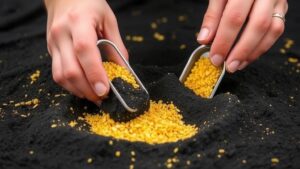Techniques for Gold Recovery in Narrow Mountain Streams
Techniques for Gold Recovery in Narrow Mountain Streams
The pursuit of gold recovery in narrow mountain streams is a nuanced endeavor that combines both traditional techniques and modern methodologies. These environments present unique challenges, including fluctuating water flow, varying sediment composition, and the often-remote locations of the streams themselves. This article explores various techniques used for gold recovery, their effectiveness, and their implications for both hobbyist prospectors and larger-scale operations.
Understanding the Geology of Gold Deposits
Before discussing recovery techniques, it is essential to understand the geological background of gold deposits. Gold is often found in alluvial deposits, which are formed by the erosional processes of streams and rivers that transport and concentrate the metal from its primary sources, typically quartz veins in surrounding bedrock.
Narrow mountain streams tend to host gold in specific locations, particularly in areas where the water slows, allowing the heavier particles to settle. The key factors influencing the location of gold include:
- Gradient of the stream
- Presence of bedrock outcroppings
- Natural obstructions such as boulders and logs
Classic Panning Techniques
Gold panning is one of the oldest methods used in gold recovery and remains popular due to its simplicity and low cost. It involves the use of a shallow pan to separate gold from sediment.
To effectively pan for gold:
- Choose a pan with deep sides to prevent the materials from spilling.
- Fill the pan with sediment from the stream and submerge it in water, letting the particles settle.
- Gently shake the pan to allow lighter materials to wash away, leaving the denser gold particles.
While gold panning can yield modest results, the method is labor-intensive and often produces small quantities of gold. It is best utilized for recreational prospectors and as a sampling technique.
Sluicing: A More Efficient Approach
Sluicing is a step up from panning, as it involves a longer channel like a trough that captures both water and sediment. This method enhances the rate of recovery through the use of gravitational separation.
The essential components of a sluice box include:
- A riffle system that captures gold as water flows through
- A durable construction material, often aluminum or wood
Research indicates that sluicing can increase recovery rates significantly. For example, a properly operated sluice can recover up to 90% of available gold in a given sediment sample, depending on factors like water flow and riffle design.
Highbanking: Combining Techniques
Highbanking incorporates elements of both panning and sluicing, allowing for effective gold recovery while minimizing the need for manual labor. A highbanker is a powered version of a sluice box, equipped with an adjustable hopper and a water pump.
In highbanking:
- The material is shoveled into the hopper, where water is pumped from the stream.
- As the sediment flows through the sluice, gold is trapped by the riffles.
This technique enables users to process more material in less time, making it suitable for modestly scaled operations. Highbanking can yield significant amounts of gold over extended periods, with some enthusiasts reporting recoveries of several grams per day.
Using Specialized Equipment: Dredging
Dredging can be one of the most productive methods for gold recovery, particularly in areas with larger deposits. It involves a suction-based approach to remove sediment from the riverbed, directly capturing gold and other heavy minerals.
But, dredging comes with environmental implications, such as disruption to aquatic habitats and sediment displacement. As a result, regulations vary widely by region.
In practice, a small dredge can recover several ounces of gold in a single day if operated in a productive area, making this method appealing for serious, commercial prospectors.
Environmental Considerations and Regulations
Given the environmental impact of gold recovery techniques, it is crucial for prospectors to be aware of local regulations governing mining activities. Many regions require permits for operations, particularly for suction dredging or highbanking activities that may disturb ecosystems.
Plus, sustainable practices, such as minimizing streambank erosion and avoiding harmful chemicals like mercury in recovery processes, are essential for preserving local flora and fauna.
Actionable Takeaways
- Understand the geological context of your target stream to optimize recovery efforts.
- Start with basic techniques like panning before investing in more complex systems such as sluices or highbankers.
- Stay informed about environmental regulations and commit to sustainable practices to ensure the longevity of both your prospecting activity and the ecosystem.
To wrap up, gold recovery in narrow mountain streams encompasses a variety of techniques, from manual panning to sophisticated dredging systems. By understanding these methods and their implications, prospectors can effectively enhance their gold recovery efforts while also practicing environmental stewardship.


